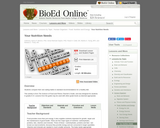
Read the Fine Print
In this lesson, students learn about food selections and compare their own diets to the USDA recommendations for a healthier diet.
- Subject:
- Health
- Healthful Living
- Material Type:
- Lesson Plan
- Provider:
- BioEd Online
- Author:
- Nancy P. Moreno, PhD, Barbara Z. Tharp, MS, Sonia Rahmati Clayton, PhD, Paula Cutler, and Martha S. Young
- Date Added:
- 02/26/2019